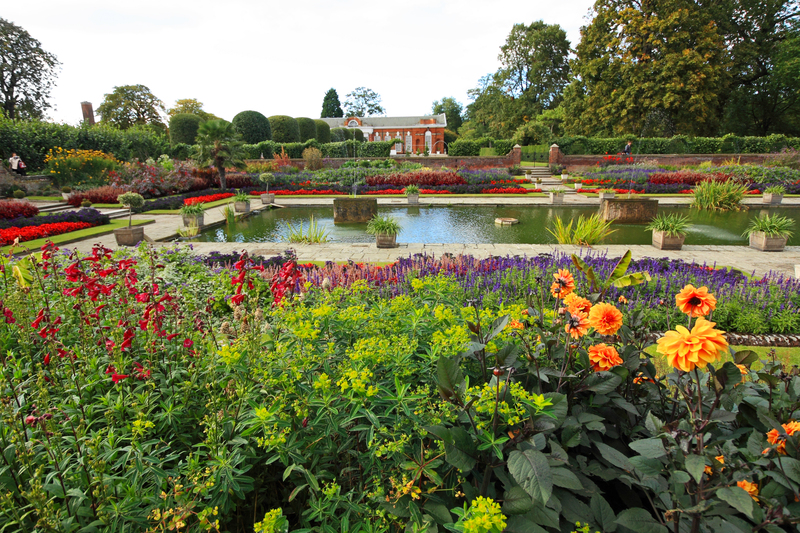Garden Resurrection: Breathing New Life into Neglect
Posted on 15/09/2025
Garden Resurrection: Breathing New Life into Neglect
Discover the secrets to transforming your forgotten outdoor space in our comprehensive guide to garden resurrection. From wild tangles and overgrown grass, to neglected flower beds and weathered features, revitalizing your garden is easier than you think. Let's embark on a journey together as we explore every aspect of breathing new life into your neglected garden.
Understanding Garden Neglect
Neglected gardens are more common than you may imagine. Life's demands, weather events, or property changes can leave even the most cherished gardens in states of disrepair. Garden restoration might seem daunting, but with patience, planning, and the right know-how, any outdoor space can bloom with vitality once again.
- Time and attention: Often, lack of time is the primary culprit.
- Invasive plants: Weeds and self-seeding species can quickly take over.
- Weather impact: Storms, drought, and frost can damage once-thriving plants.
- Personal changes: Home sales, new jobs, or family additions can shift priorities.
To start your garden resurrection, first accept that every patch of wilderness holds hidden potential, waiting to be revealed and nurtured.

The First Steps: Assessing Your Neglected Garden
1. Survey the Situation
Start by walking through your garden, notebook in hand. Identify the most overgrown zones, potential hazards (like unstable structures), and any surprises - such as surviving perennials or garden ornaments. Take photos for future reference, as these will serve as inspiring "before" images and help in monitoring progress.
2. Map Out Key Zones
Dividing your garden into manageable sections or "zones" can make the resurrection process far less overwhelming. Start with high-traffic areas or spots nearest to your home, and move outward into wilder territories.
- Primary entryways and walkways
- Patios, decks, or seating areas
- Flower and vegetable beds
- Lawn and grassy stretches
- Hidden corners or unsightly dumping areas
Clearing the Canvas: Removing Debris and Overgrowth
Garden clean-up is the foundation of any successful transformation. This initial clearing phase uncovers the hidden "bones" of your outdoor space--paths, borders, trees, and structures.
Debris and Waste Removal Tips
- Start with hard surfaces: Sweep patios and paths to expose their boundaries.
- Remove rubbish: Collect broken pots, plastics, or discarded furniture.
- Weed wisely: Uproot weeds and invasive plants from beds and crevices. Consider using eco-friendly weed control methods rather than harsh chemicals.
- Prune overgrown shrubs: Carefully trim back bushes and trees, allowing more light to penetrate the garden.
- Compost organic waste: Convert leaves, cuttings, and grass clippings into valuable compost.
Completing these steps will reveal the shape and character of your neglected garden, inspiring you for the next phase.
Soil Revival: Restoring Fertility
Healthy soil is the backbone of a vibrant garden. Years of neglect can lead to compacted, nutrient-depleted, or waterlogged earth. The good news? Soil can be revived with relative ease and a few simple tools.
Techniques for Soil Resurrection
- Aerate the ground: Use a fork or aerator to introduce air and break up compaction.
- Incorporate organic matter: Dig in compost, leaf mold, or well-rotted manure to replenish nutrients.
- Test the soil: Easy-to-use soil test kits reveal pH and nutrient levels, guiding your amendments.
- Mulch beds: Retain moisture and suppress weeds with bark chips, straw, or homemade compost.
Restoring soil fertility is a foundational step in breathing life back into your garden. Your plants will reward you with better health and resilience.
Saving, Replacing, or Introducing Plants
A central mission of your garden resurrection journey is to evaluate which existing plants are salvageable, which should be removed, and where new planting can reinvigorate your landscape.
Evaluating Existing Vegetation
- Healthy survivors: Identify robust shrubs, trees, and perennials worth keeping.
- Tired or diseased plants: Remove those that are unlikely to recover.
- Self-seeders: Consider keeping attractive "volunteers" or thinning where necessary.
Adding New Life
When introducing new plants, opt for varieties suited to your region's climate and your garden's current conditions (sun exposure, soil type, moisture levels). Native plants are a fantastic choice, providing habitat for wildlife and demonstrating outstanding resilience.
- Perennials: Offer long-lasting color with minimal maintenance.
- Annuals: Deliver quick, seasonal bursts of vibrancy.
- Herbs and vegetables: Perfect for edible and fragrant displays.
- Bulbs: Ensure year-round interest with spring and summer blooms.
Hardscapes and Features: Restoring Garden Structure
Garden resurrection isn't only about plants--hardscape elements like paths, patios, trellises, and fences provide vital structure and character.
Repairing and Reviving Structures
- Paths and patios: Weed between joints, repair cracks, and pressure wash surfaces.
- Fences and borders: Fix broken posts, repaint, or replace worn panels for instant uplift.
- Water features: Clean out ponds, repair pumps, and remove algae for crystal-clear attraction.
- Garden furniture: Sand, repaint or refinish wooden benches and tables.
Integrating artistic elements--such as sculptures, birdbaths, or DIY garden art--can infuse personality and focal points, inviting family and wildlife to linger.
Embracing Wildlife: Fostering a Living Landscape
As you restore your neglected garden, consider how each change can support local wildlife. Gardens buzzing with bees, fluttering butterflies and visiting songbirds are not only joyful but also beneficial for your plants and the broader ecosystem.
- Install bird feeders and nesting boxes to attract feathered friends.
- Plant pollinator-friendly flowers like lavender, salvia, and sunflowers.
- Create log or stone piles for insects and small mammals to shelter.
- Add a small pond or birdbath as a water source.
- Avoid chemical pesticides to maintain a healthy, balanced mini-ecosystem.
Your revived garden can become a sanctuary--for both you and the creatures that call it home.
Designing for the Future: Sustainable Revival
Once your outdoor space is resurrected, it's time to plan for lasting beauty and ease of maintenance. With sustainability in mind, you can ensure that your garden flourishes season after season.
Low-Maintenance Garden Ideas
- Drought-tolerant plants: Choose species that thrive on rainfall alone.
- Perennials over annuals: Reduce planting chores year-to-year.
- Mulched paths and beds: Save time watering and weeding.
- Rainwater harvesting: Install barrels or systems to catch and reuse water.
- Automated irrigation: Drip lines or soaker hoses simplify watering routines.
Creative Upcycling in the Garden
- Transform old pallets into planters or vertical gardens.
- Repurpose bricks, stones, or tiles for edging and pathways.
- Convert unused household items--like teacups or boots--into charming containers.
Maintaining Momentum: Your Revived Garden Year-Round
The resurrection of your garden doesn't end with a single surge of effort; rather, it's the beginning of a new relationship with your outdoor realm. Regular, mindful care will keep your plot flourishing.
- Seasonal tasks: Prune, divide, and plant according to what each season demands.
- Mulching and feeding: Keep roots cool, suppress weeds, and ensure continual nourishment.
- Pest watch: Inspect regularly for signs of trouble and treat naturally wherever possible.
- Plan ahead: Set a garden calendar with reminders for key jobs.
With each passing month, your efforts will deepen the revival, transforming neglect into a thriving oasis.
Real-Life Garden Resurrection Stories
From Wasteland to Wonderland: Amy's Urban Garden
Amy inherited a backyard dense with thorny brambles and abandoned junk. With only weekends free, she enlisted friends for a communal clean-up, built a compost heap, and rescued a few stubborn roses. Over two summers, she created raised veggie beds, a small wildlife pond, and filled her border with drought-tolerant perennials. Amy's story proves that neglected outdoor spaces can become beloved sanctuaries with persistence and creativity.
Rural Retreat: The Evans' Country Plot
Upon moving to a farmhouse after years of rental living, the Evans family faced waist-high weeds and a crumbling patio. Tackling one area at a time, they slowly revealed fruit trees, restored a forgotten pathway, and eventually constructed a greenhouse. Today, their country garden teems with birds and blossoms--an inspiring resurrection from neglect.
Essential Tools for Garden Renewal
- Secateurs & Loppers: For pruning back overgrowth.
- Garden forks & spades: Crucial for turning and aerating soil.
- Rake and hoe: For debris removal and weeding.
- Wheelbarrow: Makes transporting waste easy.
- Compost bin: Closes the fertility loop and reduces landfill waste.
Invest in quality tools--they pay off in effort saved and results achieved. Keep blades sharp and handles clean for safe, effective gardening.

Your Step-by-Step Checklist for Garden Resurrection
- Survey, photograph, and map your garden zones.
- Remove debris, clear overgrowth, and compost organic waste.
- Test, aerate, and amend the soil.
- Evaluate and select vegetation to save, remove, or add.
- Repair, clean, or replace hardscaping and garden features.
- Plant with an eye toward color, sustainability, and wildlife support.
- Set up a regular maintenance calendar for ongoing care.
Conclusion: The Joys of a Resurrected Garden
Reviving a neglected garden is more than an outdoor project--it's an act of renewal and hope. As tangled undergrowth gives way to vibrant blooms and buzzing life, you'll find not only visual rewards but emotional satisfaction. The garden resurrection process connects you with nature, provides space for relaxation, and boosts your property's value. Whether you start small or dream big, breathing new life into neglect can transform both your landscape and your soul.
Start your garden resurrection journey today--and watch neglected corners turn into living works of art. Your future self (and your neighbors, too) will thank you!

